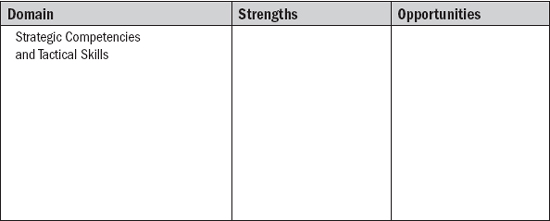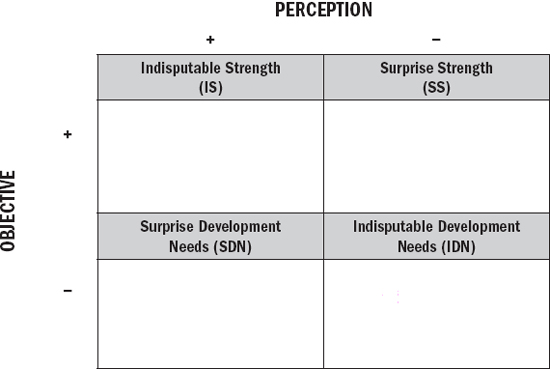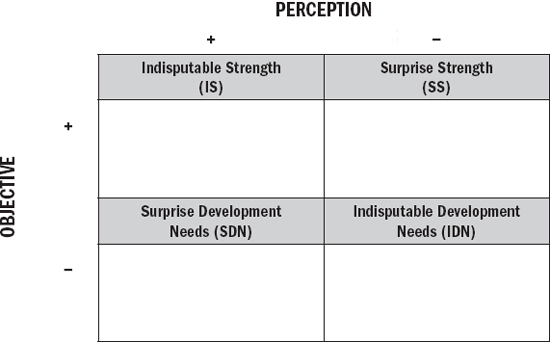
The Assessment-Driven Leadership
Individual Development
Plan
Prepared for: John
Smith ABC Corporation
February 1, 2011
Analysis of Your Job
(review Map of Success or relevant competency model)

Review of Perception-Based Assessments
(360s, Self, and Reviews)

Review of Objective-Based Assessments

Data Integration—Intrapersonal, Interpersonal,
Skills, Competencies

Data Integration Summary—3×3×3×3

The starting point in building your Individual Development Plan (IDP) is to identify the critical strategic competencies, tactical skills, interpersonal skills, and intrapersonal attributes required for success in your role as a leader. Review the Map of Success and/or other leadership competency model, and spend a few minutes thinking about your role and the critical factors that determine success.
In the space below, write down the strategic competencies (e.g., Critical Thinking), tactical leadership skills (e.g., Talent Leadership), interpersonal skills (e.g., Extroversion), and intrapersonal skills (e.g., Self-Awareness) required for success in your role as a leader. Once you have them listed, describe in your own words what you think is the absolute most important requirement for each area.
Multirater assessment data is critically important to understanding what you do and how you do it on the job. If you have multirater feedback such as 360 assessment results, you can use this section to summarize your results. With 360 data, you should put more weight on how others (i.e., your manager, peers, and direct reports) perceive you than on your own self-ratings. However, in the absence of 360 results, you should use your most recent performance review results, again placing more weight on your manager’s perception of your strengths/development opportunities. Review your multirater and/or performance review information and think about what the results reveal about your strengths and opportunities for development in each area. Note your strengths and opportunities in the space provided, and write down the specific multirater item or statement that was most important in leading you to your conclusion.

Objective-based assessments that measure your inner-core attributes—such as your self-concept, values, beliefs, predominant thinking and emotional patterns, and behavioral interpersonal tendencies—are all designed to help you understand why you do what you do. Your inner-core attributes (i.e., intrapersonal) are at the foundation of being able to predict how you behave and the skills and competencies you execute. Your inner-core attributes are typically enduring in that they have been developed, shaped, and reinforced, making them also challenging to change. Some objective assessments—such as skill-based simulations (e.g., TALENTSIM)—don’t measure inner-core attributes, but they do measure an individual’s performance potential to be able to execute the required skills and competencies that are associated with success in a leadership role. You should incorporate your MLEI Results here in the Intrapersonal section.

It is now important to compare and contrast your objective assessment results with whatever perception-based assessments you have utilized—across all three areas of defined leadership success: Intrapersonal, Interpersonal, and Tactical/Strategic Competencies. It is important to note that most 360 assessments are not focused on measuring intrapersonal attributes; sometimes, however, raters are asked to evaluate behaviors that reflect inner-core attributes such as self-awareness or self-image. Please recognize that such attributes cannot be observed directly by others; they are inferred, based on the behaviors exhibited. Therefore, as you complete the matrix you might find that you are utilizing your own self-perceptions to define the horizontal axis of the matrix—which is fine. When you start completing the matrices for the Interpersonal attributes and Skills/Competencies, it will be more appropriate to utilize your 360 assessment results (in terms of how others see you) and/or your performance review feedback results to populate the horizontal axis.
Each matrix combines two axes: Objective Assessment Results (vertical) and Perception Assessment Results (horizontal). The result is four distinct quadrants:
• Indisputable Strengths (IS): Objective assessment results reveal strengths that confirm perceptions (++)
• Surprise Strengths (SS): Objective assessment results reveal strengths that are discrepant with perceptions (+−)
• Indisputable Development Opportunities (IDO): Objective assessment results reveal development opportunities that confirm perceptions (−−)
• Surprise Development Opportunities (SDO): Objective assessment results reveal development opportunities that are discrepant with perceptions (−+)
Ultimately, the strength of your IDP will be in direct proportion to identifying with the help of your coach and key stakeholders two or three goals and action plans for each quadrant but more emphasis on the discrepant quadrants (SS & SDO) because most leaders find it empowering to be able to leverage under-used talents and deal with the blind spots that are revealed in the SDO quadrant.



In the following three matrices, carry over the two strengths and development opportunities that you believe are the most important to your success. If necessary, go back and review your work at Step 1 to help you align what is important with what is required for success in your role. After you have identified two for each quadrant, now eliminate one. That will leave you with one strength or development opportunity per quadrant and your summary matrix will contain no more than three per quadrant, hence the 3×3×3×3.
Intrapersonal
| Indisputable Strength (IS) | Surprise Strength (SS) |
| Surprise Development Needs (SDN) | Indisputable Development Needs (IDN) |
Interpersonal
| Indisputable Strength (IS) | Surprise Strength (SS) |
| Surprise Development Needs (SDN) | Indisputable Development Needs (IDN) |
Competencles/Skills
| Indisputable Strength (IS) | Surprise Strength (SS) |
| Surprise Development Needs (SDN) | Indisputable Development Needs (IDN) |
| Indisputable Strength (IS) | Surprise Strength (SS) |
| Surprise Development Needs (SDN) | Indisputable Development Needs (IDN) |